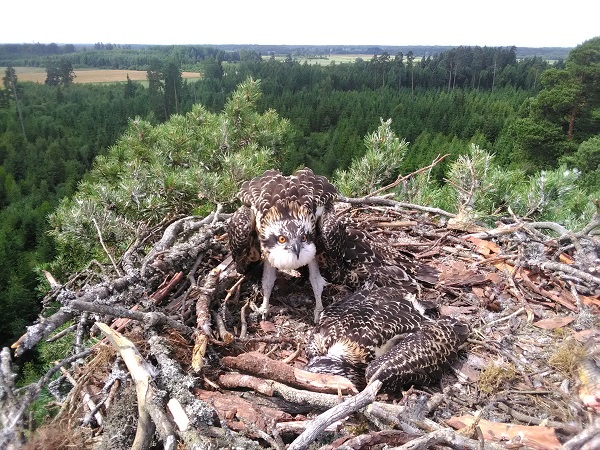Five New Territories Inhabited by the Specially Protected Osprey were Found Last Year

For 17 years, the bird monitoring carried out regularly by the environmental experts of JSC “Latvia's State Forests” (LVM) allows us to follow the progress of the nesting of a specially protected bird – the osprey. During this time, the number of territories inhabited by this rare bird has more than doubled in Latvia. Last year, as part of monitoring, a total of 240 territories were surveyed, of which inhabited nests were found in more than half of the territories.
A total of 140 osprey habitats were recorded in 2023. The number of these areas varies by region. The largest number of inhabited places are recorded in the South Kurzeme region – 34, but the smallest number, only seven – in the Zemgale and North Kurzeme regions. The majority of the inhabited territories – 118 – are located in forests managed by LVM.
Ospreys prefer to inhabit forests and swamps near water reservoirs.
“The habitats of ospreys are connected with the main food of these predatory birds – fish. The bird's anatomy is also of course suitable for consuming this type of food – its first toe is directed backward, so the osprey grasps the game with two middle fingers pointing forward and the outer toes pointing back. This special grip allows the bird to hold slippery fish. The osprey mostly feeds on small fish, but it can also catch large fish. The carp is the osprey's favourite fish in Latvia, but in some places, there can also be other fish species – the pike, the tench and others,” says Aigars Kalvāns, ornithologist and LVM Environmental Expert.
In 2023, five new, hitherto unknown territories inhabited by the osprey were also found – two in the West Vidzeme region and one in the Central Daugava, North Kurzeme, and North Latgale regions.
An average of chicks lives in each inhabited nest
LVM Environmental Expert Aigars Kalvāns points out that last year's nesting success can also be seen as good, as there were 2.39 baby birds per successful nest – this indicator is higher than the average indicator of the last 17 years. Like other years, also in 2023, the largest share of osprey couples had three babies.
More than half, or 61 %, of the 118 osprey-inhabited territories found in forests managed by LVM had successful nests – this means that at least one bird hatched and flew out of these nests. The largest number of successful nests – 22 – was registered in the West Vidzeme region, while the smallest number, only four, was found in the North Kurzeme region.
During the 17 years, the dynamics of successful osprey nests have been positive in almost all regions, except for the Northern Kurzeme region, which also lags in terms of inhabited areas. “There are no specific reasons why such a situation has arisen in the Northern Kurzeme region. This is probably related to the increase in the number of sea eagles, which has generally increased throughout the territory of Latvia. The highest density of sea eagles is to be observed in Kurzeme. In places where there is enough food, both species are able to coexist, but in places where there is not enough food, the sea eagle starts to chase the osprey to take away its caught fish. Sea eagles often carry away osprey babies. That is why the osprey begins to avoid nesting in places where there are sea eagles in the vicinity,” says ornithologist Aigars Kalvāns.
There is a significant number of rare and protected species nesting in LVM areas, most of them such as the golden eagle, the white-tailed eagle, the osprey, the lesser spotted eagle, the northern goshawk, the black stork, and the capercaillie live in the forests managed by the company.
Bird monitoring carried out by LVM allows to obtain information about the living conditions preferred by bird species and to reduce the impact of forestry activities on the living conditions of rare and protected species. To ensure the protection of the osprey and other birds, LVM significantly restricts economic activity in the territories inhabited by the bird: following the regulations, it encourages the creation of new micro-reserves, creates certain areas for the protection of habitats, and around them – buffer zones, where the restrictions for forestry work during the nesting period are imposed.




